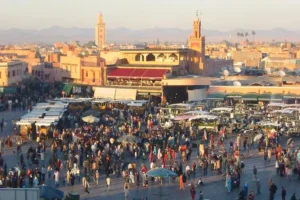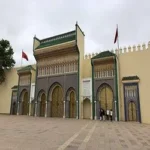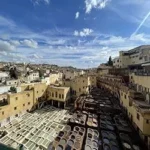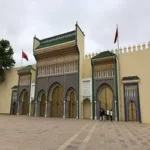Things to do in Marrakesh
Things to do in Marrakesh:
 Things to do in Marrakesh. Marrakech Founded around 1062 by the Almoravids, Marrakech is one of Morocco’s four Imperial Cities, along with Méknes, Fes and Rabat. It would go on to become the capital of the Almohad caliphate in the 12th century, which sprawled through Spain and Africa.
Things to do in Marrakesh. Marrakech Founded around 1062 by the Almoravids, Marrakech is one of Morocco’s four Imperial Cities, along with Méknes, Fes and Rabat. It would go on to become the capital of the Almohad caliphate in the 12th century, which sprawled through Spain and Africa.
During this period, Marrakech was blessed with its mighty walls built from red sandstone, gleaming mosques like Koutoubia, fine gardens and palaces. The architectural influence of the Almohads was strong and featured carved domes and arches. When blended with influences from the Sahara and West Africa, it created a unique style of architecture in the city.
Marrakech’s rapid growth turned it into a cultural, religious and trading centre and despite a later period of decline, it resurged in the 16th century during the reign of wealthy Saadian sultans, who built magnificent palaces such as El Badi Palace.
Until 1867, Europeans were forbidden from entering the city unless they were granted permission from the sultan. By the early 20th century, when the country was overwhelmed with unrest, the French were able to colonise Morocco. French influence lingers on in the wide boulevards of the new town, Guéliz, and its few remaining art deco villas, most notably landscape painter Jacques Majorelle’s stylish cobalt blue retreat in the Jardin Majorelle. But the most significant legacy of colonial rule is the French language, which is still spoken by all educated Moroccans.
After WWII, a vast array of pleasure-seekers rediscovered Marrakech. Winston Churchill, Yves Saint Laurent and the Rolling Stones rubbed shoulders with American beat writers, hippies and a new breed of curious visitors anxious to see what all the fuss was about. More recently, a tourism drive led by King Mohammed VI has resulted in new luxury hotels, shops and restaurants. A moderate constitutional monarch, he has been responsible for social reforms and gave parliament new powers.
Things To See In Marrakesh?
The Bahia Palace, means brilliance and beautiful in Arabic language, Bahia palace considered one of the best-preserved historical sites and most interesting site to visit in Marrakech. Bahia Palace was Built between 1866 and 1867 by Si Moussa, this sprawling palace is set over two acres in the middle of the Marrakech medina and features 150 rooms, including a harem section located just off the sun-filled Court of Honour. Having housed the Resident General during the French Protectorate era, today the Bahia Palace is a must-see historical museum open to the public daily and has previously hosted events such as the Marrakech Biennale.
Bahia Palace Originally built for the personal use of Si Moussa, Grand Vizier of the Sultan, a former slave who climbed the ranks, the house was soon after occupied by his son Bou Ahmed. He slyly rose to power in 1894 when he managed to gain complete control over the state until his death in 1900. It was during Bou Ahmed’s reign that the brilliance of the Bahia palace was really enhanced with the addition lush gardens, the small riad surrounding private gardens (of which visitors today pass through immediately upon entering the palace area) and each of the rooms decorated in truly elegant Moroccan style – carved stucco and cedarwood to decorate each of the rooms of bahia palace.
The bahia palace houses council rooms with impressive zellig fireplaces, flooring and painted cedarwork, a large riad surrounded by citrus trees, and the Court of Honour that was built during Si Moussa’s power. The bahia palace was also the residence of Bou Ahmed, his four wives and several concubines. Though the harem, as it is often known, is off-limits to visitors, you can visit the traditional style gardens that are filled with orange trees and splashing fountains with living quarters and apartments, most notably that of his wife Lalla Zinab. Beautifully zellig-tiled fireplaces and floors and colourful stained-glass windows create colourful patterns in the afternoon sun, and beautifully painted and carved cedarwood are just some of the interesting features in his wife’s Riad.
Following Ba Ahmed’s death in 1900, it is said that the bahia palace was ransacked and all valuables were removed. With the arrival of the French in the early 1900s, the residents were forced to move out to make way for the Resident General.
The Saadian Tombs are a historic royal necropolis in Marrakesh, Morocco, located on the south side of the Kasbah Mosque, inside the royal kasbah (citadel) district of the city. They date to the time of the Saadian dynasty and in particular to the reign of Ahmad al-Mansur (1578–1603), though members of Morocco’s monarchy continued to be buried here for a time afterwards.
The Saadian tombs is one of the sightseeing in Marrakech are the only remains of the Saadian dynasty, founders of Marrakech, as the other constructions were destroyed by Sultan Moulay in the 18th century. The saadian tombs were built at the time of the sultan Ahmad al-Mansur (1578-1603) and forgotten for centuries before being discovered around 1917. Restored by the department of “Les Beaux Arts”, Saadian Tombs now impress visitors by the beauty their decoration.
The mausoleum contains the body of sixty Saadians, including Sultan Al-Mansour, his successors and his family. The saadian tombs building has three rooms including the most prestigious mausoleum which is the room of twelve columns, the tomb of Sultan Ahmed El Mansour. Its carved cedar wood dome and stucco are finely crafted and the graves are made of Carrara marble from Italy. This mausoleum is a fine example of Moorish decorative art. Outside, we can find raves of soldiers and servants and a garden of the necropolis.
The early history of the necropolis is not well known. The necropolis is located right behind the qibla wall (in this case the southeastern wall) of the Kasbah Mosque, which was built, along with the surrounding royal kasbah (citadel), by the Almohad ruler Abu Yusuf Ya’qub al-Mansur in the late 12th century. Accordingly, it is believed that this was the site of a necropolis even in Almohad times, though there’s no evidence of any significant figures being buried here at that time (the Almohad rulers were buried at Tinmal instead)
The Jemaa el-Fna Square is one of the main cultural spaces in Marrakesh and has become one of the symbols of the city since its foundation in the eleventh century. It represents a unique concentration of popular Moroccan cultural traditions performed through musical, religious and artistic expressions.
Located at the entrance of the Medina, this triangular square, which is surrounded by restaurants, stands and public buildings, provides everyday commercial activities and various forms of entertainment. It is a meeting point for both the local population and people from elsewhere. All through the day, and well into the night, a variety of services are offered, such as dental care, traditional medicine, fortune-telling, preaching, and henna tattooing; water-carrying, fruit and traditional food may be bought. In addition, one can enjoy many performances by storytellers, poets, snake-charmers, Berber musicians (mazighen), Gnaoua dancers and senthir (hajouj) players. The oral expressions would be continually renewed by bards (imayazen), who used to travel through Berber territories. They continue to combine speech and gesture to teach, entertain and charm the audience. Adapting their art to contemporary contexts, they now improvise on an outline of an ancient text, making their recital accessible to a wider audience.
The Jemaa el-Fna Square is a major place of cultural exchange and has enjoyed protection as part of Morocco’s artistic heritage since 1922. However, urbanization, in particular real estate speculation and the development of the road infrastructure, are seen as serious threats to the cultural space itself. While Jemaa el-Fna Square enjoys great popularity, the cultural practices may suffer acculturation, also caused by widespread tourism.
The Majorelle Garden was designed by the French artist, Jacques Majorelle (1886-1962), son of the Art Nouveau ébéniste (cabinet-maker) of Nancy, Louis Majorelle. As a young aspiring painter, Jacques Majorelle was sent to Morocco in around 1917 to convalesce from a serious medical condition. After spending a short time in Casablanca, he travelled to Marrakech and like many of his contemporaries, fell in love with the vibrant colours and street life he found there. After travelling around North Africa and the Mediterranean, he eventually decided to settle permanently in Marrakech
During his lifetime, Majorelle earned a reputation as a celebrated Orientalist painter. The special shade of bold cobalt blue, inspired by the coloured tiles he had seen around Marrakech and in Berber burn-houses, was used extensively in the garden and its buildings and is named after him, bleu Majorelle—Majorelle Blue. Prior to his death, Majorelle patented the colour which carries his name
In 1923, just four years after his marriage to Andrée Longueville, Majorelle purchased a four-acre plot, situated on the border of a palm grove in Marrakech and built a house in the Mooroccan style. In 1931, he commissioned the architect, Paul Sinoir, to design a Cubist villa for the property. Gradually, he purchased additional land, extending his holding by some 10 acres. In the grounds around the residence, Majorelle began planting a luxuriant garden which would become known as the Jardins Majorelle (Majorelle Garden). The garden became his life’s work and he devoted himself to developing it for almost forty years
The garden proved costly to run and in 1947, Majorelle opened the garden (majorelle garden) to the public with an admission fee designed to defray the cost of maintenance. At times, he sold off parcels of land to fund the growing garden. Following his divorce in the 1950s, Majorelle was forced to sell the house and land. After this, the majorelle garden was neglected and fell into disrepair. The majorelle garden and villa were rediscovered in the 1980s, by fashion designers, Yves Saint-Laurent and Pierre Bergé who set about restoring it and saving it. The pair owned the villa until 2008. After Yves Saint Laurent died in 2008 his ashes were scattered in the Majorelle Garden
Since 2010, the majorelle garden has been owned by the Foundation Pierre Bergé – Yves Saint Laurent, a French not-for-profit organisation and since 2011 has been managed by the Foundation Jardin Majorelle (majorelle garden), a recognized non-profit organization in Marrakech. Pierre Bergé was the director of the Garden’s Foundation until his death in September, 2017.
Gardens and museums
The gardens and buildings form a complex, where specific buildings are dedicated to various museums and exhibits of interest to visitors. The gardens, which cover two and half acres, are open to the public daily and house an important collection of cacti and sculptures.
Majorelle’s former studio workshop previously housed the Islamic Art Museum of Marrakech, featuring a collection of North African textiles from Saint-Laurent’s personal collection as well as ceramics and jewelry. Since 2011, however, the villa is now home to the Berber Museum (Musée Pierre Bergé des Arts Berbères), exhibiting objects of Amazigh (Berber) culture. The villa also holds a collection of Majorelle’s paintings.
Development of the majorelle garden complex is ongoing. Profits from the gardens are used to fund new projects. In October 2017, the Yves Saint Laurent Museum was opened to the public as a tribute to the designer’s legacy and his links with Marrakech. The gardens are a major tourist drawcard in Marrakech, attracting more than 700,000 visitors annually. The majorelle garden hosts more than 15 bird species that are endemic to North Africa. It has many fountains, and a notable collection of cacti





